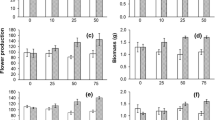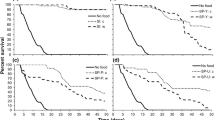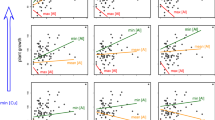Abstract
Nickel hyperaccumulating plants have more than 1000 mg Ni kg−1 dry weight when grown on nickel-bearing soils. We hypothesized that Ni hyperaccumulation could serve as a chemical defense against herbivores In feeding experiments with potential insect herbivores and Ni hyperaccumulating plants, only those inseets fed leaves from plants grown on non-nickel-bearing soil survived or showed a weight gain. Among chemical parameters measured, only Ni content of plants was sufficient to explain this result. When subjected to herbivory by lepidopteran larvae, plants grown on Ni-amended soil showed greater survival and yield than plants on unamended soil. Ni hyperaccumulation may be an effective plant chemical defense against herbivores because of its high lethality, apparent low cost, and broad spectrum of toxicity.
Similar content being viewed by others
References
Baker AJM, Brooks RR (1989) Terrestrial higher plants which accumulate metallic elements — a review of their distribution, ecology and phytochemistry. BioRecovery 1:81–126
Baker AJM, Proctor J (1988) Ecological studies on forest over ultrabasic rocks in the Philippines. Bull Br Ecol Soc 19:29–34
Borovik AJ (1989) Characterizations of metal ions in biological systems. In: Shaw AJ (ed) Heavy metal tolerance in plants: evolutionary aspects. CRC Press, Boca Raton, pp 3–5
Boyd RS, Martens SN (1992) The raison d'etre of metal hyperaccumulation by plants. In: Baker AJM, Proctor J, Reeves RD (eds) The vegetation of ultramafic (serpentine) soils. Intercept, Andover, pp 279–289
Brooks RR (1987) Serpentine and its vegetation. Dioscorides, Portland
Brooks RR, Lee J, Reeves RD, Jaffre T (1977) Detection of nickeliferous rocks by analysis of herbarium specimens of indicator plants. J Geochem Explor 7:49–57
Brooks RR, Reeves RD, Baker AJM, Rizzo JA, Diaz Ferreira H (1990) The Brazilian serpentine plant expedition (BRASPEX), 1988. Nat Geogr Res 6:205–219
Brown TA, Shrift A (1982) Selenium: toxicity and tolerance in higher plants. Biol Rev 57:59–84
Coley PD, Bryant JP, Chapin FS III (1985) Resource availability and plant anti-herbivore defense. Science 230:895–899
Ernst WHO (1987) Population differentiation in grassland vegetation. In: Andel J van, Bakker JP, Snaydon RW (eds) Disturbance in grasslands. Causes, effects and processes. Junk, Dordrecht, pp 213–228
Ernst WHO, Schat H, Verkleij JAC (1990) Evolutionary biology of metal resistance in Silene vulgaris. Evol Trends Plants 4:45–51
Futuyma DJ (1983) Evolutionary interactions among herbivorous insects and plants. In: Futuyma DJ, Slatkin M (eds) Coevolution. Sinauer, Sunderland, pp 207–231
Gabbrielli R, Mattioni C, Vergnano O (1991) Accumulation mechanisms and heavy metal tolerance of a nickel hyperaccumulator. J Plant Nutr 14:1067–1080
Garth JS, Tilden JW (1986) California butterflies. University of California Press, Berkeley
Hopkin SP (1989) Ecophysiology of metals in terrestrial invertebrates. Elsevier, Barking
Jaffre T, Brooks RR, Lee J, Reeves RD (1976) Sebertia acuminata: a nickel accumulating plant from New Caledonia. Science 193:579–580
Karban R, Courtney S (1987) Intraspecific host plant choice-lack of consequences for Streptanthus tortuosus (Cruciferae) and Euchloe hyantis (Lepidoptera: Pieridae). Oikos 48:243–248
Klerks PL (1989) Adaptation to metals in animals. In: Shaw AJ (ed) Heavy metal tolerance in plants: evolutionary aspects. CRC Press, Boca Raton, pp 313–321
Krieger RI, Feeny PP, Wilkinson CF (1971) Detoxication enzymes in the guts of caterpillars: an evolutionary answer to plant defenses? Science 172:579–581
Kruckeberg AR (1984) California serpentines. University of California Press, Berkeley
Lee J, Reeves RD, Brooks RR, Jaffre T (1978) The relation between nickel and citric acid in some nickel-accumulating plants. Phytochemistry 17:1033–1035
Minguzzi C, Vergnano O (1948) II contenuto di nichel nelle ceneri di Alyssum bertolonii Desv. Mem Soc Tosc Sci Nat Ser A 55:49–71
Morrison JF, Peters RA (1954) Biochemistry of fluoroacetate poisoning: the effect of fluorocitrate on purified aconitase. Biochem J 58:473–479
Nieboer E, Rossetto FE, Menon CR (1988) In: Sigel H, Sigel A (eds) Nickel and its role in biology. Metal ions in biological systems vol 23. Dekker, New York, pp 359–402
Oelrichs PB, McEwan T (1961) Isolation of the toxic principle of Acacia georginae. Nature 190:808–809
Reeves RD (1992) The hyperaccumulation of nickel by serpentine plants. In: Baker AJM, Proctor J, Reeves RD (eds) The vegetation of ultramafic (serpentine) soils. Interept, Andover, pp 253–277
Reeves RD, Baker AJM (1984) Studies on metal uptake by plants from serpentine and non-serpentine populations of Thlaspi goesingense Halacsy (Cruciferae). New Phytol 98:191–204
Reeves RD, MacFarlane RM, Brooks RR (1983) Accumulation of nickel and zinc by western North American genera containing serpentine-tolerant species. Am J Bot 70:1297–1303
Rosenfeld I, Beath OA (1964) Selenium: geobotany, biochemistry, toxicity, and nutrition. Academic Press, New York
Schlegel HG, Cosson J-P, Baker AJM (1991) Nickel-hyperaccumulating plants provide a niche for nickel-resistant bacteria. Bot Acta 104:18–25
Severne BC (1974) Nickel accumulation by Hybanthus floribundus. Nature 248:807–808
Twigg LE, King DR (1991) The impact of fluoroacetate-bearing vegetation on native Australian fauna: a review. Oikos 61:412–430
Wild H (1975) Termites and the serpentines of the Great Dyke of Rhodesia. Trans Rhod Sci Assoc 57:1–11
Author information
Authors and Affiliations
Rights and permissions
About this article
Cite this article
Martens, S.N., Boyd, R.S. The ecological significance of nickel hyperaccumulation: a plant chemical defense. Oecologia 98, 379–384 (1994). https://doi.org/10.1007/BF00324227
Received:
Accepted:
Issue Date:
DOI: https://doi.org/10.1007/BF00324227




